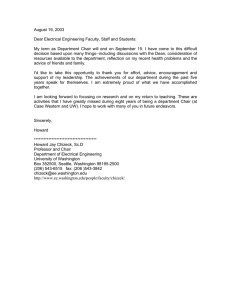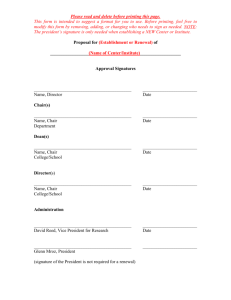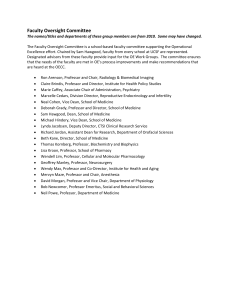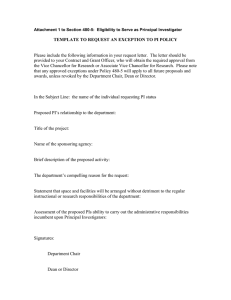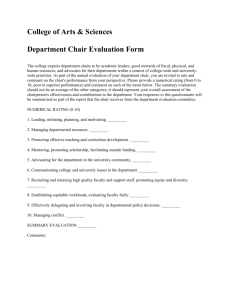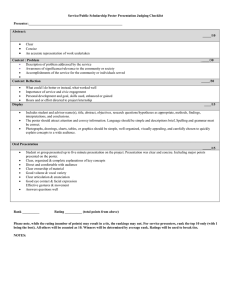UNIVERSITY OF SOUTH ALABAMA ANNUAL FACULTY EVALUATION General Information
advertisement
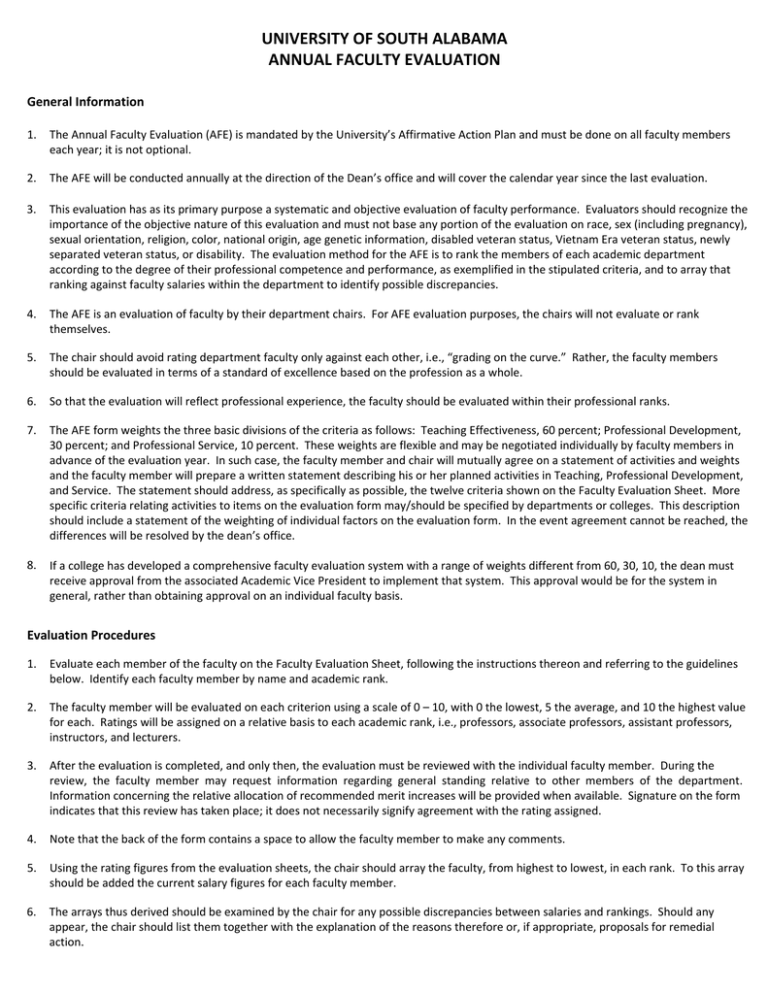
UNIVERSITY OF SOUTH ALABAMA ANNUAL FACULTY EVALUATION General Information 1. The Annual Faculty Evaluation (AFE) is mandated by the University’s Affirmative Action Plan and must be done on all faculty members each year; it is not optional. 2. The AFE will be conducted annually at the direction of the Dean’s office and will cover the calendar year since the last evaluation. 3. This evaluation has as its primary purpose a systematic and objective evaluation of faculty performance. Evaluators should recognize the importance of the objective nature of this evaluation and must not base any portion of the evaluation on race, sex (including pregnancy), sexual orientation, religion, color, national origin, age genetic information, disabled veteran status, Vietnam Era veteran status, newly separated veteran status, or disability. The evaluation method for the AFE is to rank the members of each academic department according to the degree of their professional competence and performance, as exemplified in the stipulated criteria, and to array that ranking against faculty salaries within the department to identify possible discrepancies. 4. The AFE is an evaluation of faculty by their department chairs. For AFE evaluation purposes, the chairs will not evaluate or rank themselves. 5. The chair should avoid rating department faculty only against each other, i.e., “grading on the curve.” Rather, the faculty members should be evaluated in terms of a standard of excellence based on the profession as a whole. 6. So that the evaluation will reflect professional experience, the faculty should be evaluated within their professional ranks. 7. The AFE form weights the three basic divisions of the criteria as follows: Teaching Effectiveness, 60 percent; Professional Development, 30 percent; and Professional Service, 10 percent. These weights are flexible and may be negotiated individually by faculty members in advance of the evaluation year. In such case, the faculty member and chair will mutually agree on a statement of activities and weights and the faculty member will prepare a written statement describing his or her planned activities in Teaching, Professional Development, and Service. The statement should address, as specifically as possible, the twelve criteria shown on the Faculty Evaluation Sheet. More specific criteria relating activities to items on the evaluation form may/should be specified by departments or colleges. This description should include a statement of the weighting of individual factors on the evaluation form. In the event agreement cannot be reached, the differences will be resolved by the dean’s office. 8. If a college has developed a comprehensive faculty evaluation system with a range of weights different from 60, 30, 10, the dean must receive approval from the associated Academic Vice President to implement that system. This approval would be for the system in general, rather than obtaining approval on an individual faculty basis. Evaluation Procedures 1. Evaluate each member of the faculty on the Faculty Evaluation Sheet, following the instructions thereon and referring to the guidelines below. Identify each faculty member by name and academic rank. 2. The faculty member will be evaluated on each criterion using a scale of 0 – 10, with 0 the lowest, 5 the average, and 10 the highest value for each. Ratings will be assigned on a relative basis to each academic rank, i.e., professors, associate professors, assistant professors, instructors, and lecturers. 3. After the evaluation is completed, and only then, the evaluation must be reviewed with the individual faculty member. During the review, the faculty member may request information regarding general standing relative to other members of the department. Information concerning the relative allocation of recommended merit increases will be provided when available. Signature on the form indicates that this review has taken place; it does not necessarily signify agreement with the rating assigned. 4. Note that the back of the form contains a space to allow the faculty member to make any comments. 5. Using the rating figures from the evaluation sheets, the chair should array the faculty, from highest to lowest, in each rank. To this array should be added the current salary figures for each faculty member. 6. The arrays thus derived should be examined by the chair for any possible discrepancies between salaries and rankings. Should any appear, the chair should list them together with the explanation of the reasons therefore or, if appropriate, proposals for remedial action. 7. Using the same rating figures, the chair should rank the entire department faculty in the same way without regard for professional level. 8. The chair should submit a copy of each individual evaluation sheet, the ranking by levels with salaries, the overall departmental ranking, and the necessary explanations and proposals to the dean’s office. An array showing the allocation of merit dollars should be submitted when available. Guidelines for Using the Faculty Evaluation Form 1. Classroom and Laboratory Performance. This category covers the overall teaching effectiveness of the faculty member, including that portion of the learning experience that may take place through student-teacher interaction outside the classroom. The chair should take into account: the number, level, and repetitiveness of courses taught; documents such as assignments sheets exams and copies of class records; and the results of a survey of student perceptions. The means by which classroom performance is determined and applied to item 1 should be specifically described by the department or college. Additionally, the weight for item 1 as a portion of the Teaching Effectiveness category should be described. 2. Academic Advising. This category covers formal academic counseling specifically and should not be used to reflect the faculty member’s enthusiasm for informal colloquies with students. The chair should take into account that advising may be assigned and that students are not required to have appointments. The availability of the faculty members, particularly during advising periods, and the conscientiousness in guiding students positively and in an orderly direction through the curriculum should be the primary measure for this item. 3. Other. This category of activities should be specified and may include, but is not limited to: course design or new course development, use of guest lecturers, supervision of independent research or capstone experience, and use of high-impact practices found in campuswide initiatives (e.g. Team-Based Learning, Learning Communities, Internships and Service Learning). 4. Publications. As with research, it is important to discriminate between professional publication and publication extraneous to the faculty member’s field. Also, scholarly journals vary in prestige; a single article in a major publication may be equivalent to three or four articles in lesser ones. 5. Research, Grant Activity. This category should reflect all professionally oriented research or creative activities of the particular faculty member, whether or not they result in publication. Grant activity should be reflected here. 6. Participation in Professional Institutes, Workshops, Conferences, etc. The category should reflect any participation in professional activities which enhance skills and knowledge in professional areas. 7. Presentations to Professional Organizations. Here again, it is important to consider the element of professionalism. A talk given to the Rotary Club or the Junior League, for example, would not properly be included under this category. 8. Other. This category of activities should be specified, but may include such activities as official professional recognition, or commendation, offices held in professional groups, activities such as serving as an editor, researcher, or abstractor on a continuing basis for a professional journal, or a prestigious lecture or seminar appointment, etc. 9. Committee Service. The score here should reflect the faculty member’s participation in and contribution to the work of the universitywide, collegiate, and departmental committees and councils, and the Faculty Senate. 10. Extracurricular Participation, etc. The chair should solicit from the faculty member the nature of individual involvement in extracurricular student organizations and activities. 11. Community Service. This item reflects University-related community service, such as providing continuing education, professional consulting or expert testimony, speaking before groups on behalf of the University or the profession, career guidance visits to high schools, etc. 12. Other. This category of activities should be specified, but may include such activities as University-related clinical service, service on advisory boards, etc. 13. Special Service or Assignment. This category of activities should be specified, but may include such activities as departmental chairs’ administrative function, special assignment such as Chair of the Faculty Senate, etc. UNIVERSITY OF SOUTH ALABAMA ANNUAL FACULTY EVALUATION Name_________________________________________ Rank________________________ Dept.________________ Rank the faculty member on each of the following twelve criteria, according to national professional standards, using a scale of 0 – 10 (0 = lowest, 5=average, 10=highest). Multiply the ratings by the rating factor for your particular department, and then add the results to get the overall rating figure. Teaching Effectiveness (Typically 60 %) 1. Classroom and laboratory (clinical, where appropriate) performance 2. Academic Advising 3. Other (specify) Professional Development (Typically 30%) Rating x X X X 4. Publications 5. Research, grant activity 6. Participation in professional institutes, workshops, courses, conferences, etc. 7. Presentations to professional organizations 8. Other (specify) X X X X X Weighting Factor Weighted Professional Service (Typically 10 %) 9. Committee Service 10. Extracurricular participation (student organization advisor, etc.) 11. University-related community service 12. Other (specify) Rating Weighting Factor x Weighted X X x x Special Service or Assignment (Specify) x Total Rating Rated By Date This signifies that I have had the opportunity to see and discuss this evaluation, and I reserve the right to submit a written rebuttal of this evaluation to the dean within ten working days of this date. Faculty Member’s Signature Faculty Member’s Comments: Date

